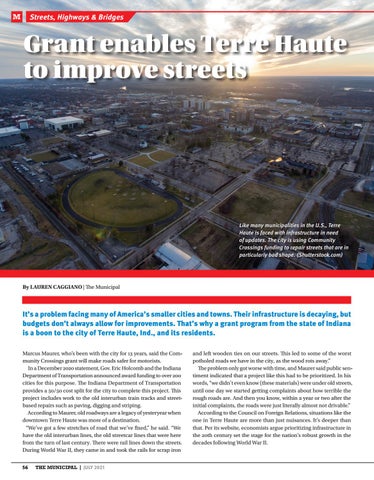M
Streets, Highways & Bridges
Grant enables Terre Haute to improve streets
Like many municipalities in the U.S., Terre Haute is faced with infrastructure in need of updates. The city is using Community Crossings funding to repair streets that are in particularly bad shape. (Shutterstock.com)
By LAUREN CAGGIANO | The Municipal
It’s a problem facing many of America’s smaller cities and towns. Their infrastructure is decaying, but budgets don’t always allow for improvements. That’s why a grant program from the state of Indiana is a boon to the city of Terre Haute, Ind., and its residents. Marcus Maurer, who’s been with the city for 13 years, said the Community Crossings grant will make roads safer for motorists. In a December 2020 statement, Gov. Eric Holcomb and the Indiana Department of Transportation announced award funding to over 200 cities for this purpose. The Indiana Department of Transportation provides a 50/50 cost split for the city to complete this project. This project includes work to the old interurban train tracks and streetbased repairs such as paving, digging and striping. According to Maurer, old roadways are a legacy of yesteryear when downtown Terre Haute was more of a destination. “We’ve got a few stretches of road that we’ve fixed,” he said. “We have the old interurban lines, the old streetcar lines that were here from the turn of last century. There were rail lines down the streets. During World War II, they came in and took the rails for scrap iron 56 THE MUNICIPAL | JULY 2021
and left wooden ties on our streets. This led to some of the worst potholed roads we have in the city, as the wood rots away.” The problem only got worse with time, and Maurer said public sentiment indicated that a project like this had to be prioritized. In his words, “we didn’t even know (these materials) were under old streets, until one day we started getting complaints about how terrible the rough roads are. And then you know, within a year or two after the initial complaints, the roads were just literally almost not drivable.” According to the Council on Foreign Relations, situations like the one in Terre Haute are more than just nuisances. It’s deeper than that. Per its website, economists argue prioritizing infrastructure in the 20th century set the stage for the nation’s robust growth in the decades following World War II.




















